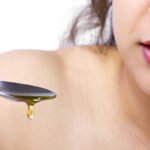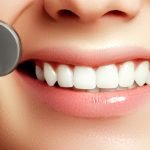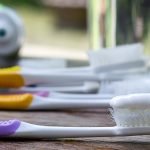Comedian Rodney Dangerfield once joked, “I told my dentist my teeth are going yellow. He told me to wear a brown tie.” Wardrobe matching may work for Dangerfield, but for the typical person, discoloration signals a call to action.
Americans spend more than $1.4 billion each year on over-the-counter teeth whitening products—and that doesn’t count money spent on whitening supervised by dentists.1 Research America. http://www.researchamerica.org/research_cents In fact, teeth whitening is now the Number One cosmetic procedure done in the US.2 Mapes, Diane. “Blindingly white: Teeth bleaching gone too far. 17 January 2007. NBCNews.com. http://www.nbcnews.com/id/15309784/#.UbEOetj6TkY And that number most likely will continue to grow, given the fact that the population is aging and increasingly gorging on substances that stain teeth. Older teeth tend to yellow-up anyway as the years deposit residues of staining foods and substances. Add to that the fact that we’re consuming more coffee, chocolate, juices, and red-wine than in years past, and you have the perfect storm for discolored teeth—and an industry salivating to remedy the ugliness.
Since discoloration is a cosmetic issue, it’s not surprising that dentists have color charts for your choppers just the way hairdressers do for your hair. Apparently, just like we’re born with a particular hair color—blond, red, black, or brown—our teeth also fall into one of four natural color ranges. We’re either reddish-brown, reddish-yellow, gray, or reddish gray—and unlike with hair where you lose your natural color as you get older, your teeth grow into their natural color the older you get. Who knew? So as a third-grader, your teeth may be almost white, but by the time you get your AARP card, they could be closer to vampire reddish-yellow–or zombie dingy gray, as the case may be.3 “How do I know what shade my teeth are?” Colgate. 6 June 2013. http://www.colgate.com/app/CP/US/EN/OC/Information/Articles/Cosmetic-Dentistry/Tooth-Whitening/Tooth-Whitening-Treatment/article/How-Do-I-Know-what-Shade-My-Teeth-are.cvsp
Within each color group, there are about 11 gradations, from near white to dark. Teeth whitening products aim to take you down at least a few shades within your color group, back to the youthful days before coffee stains marred your smile. Toothpaste is the entry-level product, and it makes less grand claims than its big siblings—the whitening strips and dental procedures that supposedly can restore you almost back to the dazzle of days past. Whitening toothpastes merely claim that they can bring you down a shade or two in color. Do they, in fact, fulfill that promise? And are they safe to use?
Toothpaste employs abrasive agents to remove surface stains from tooth enamel, and some also contain various chemicals or enzymes intended to assist. The enzymes don’t lighten teeth–they simply prevent further darkening. But according to British dentist Dr. Joe Oliver, the stains on the enamel that toothpaste reaches are only an iota of the discoloration problem. He says, “The dentine (aka dentin), which is the main body of the tooth, also affects the color. As we age, the dentine becomes more dense, which makes teeth look darker.” Toothpaste can’t penetrate beyond the enamel in the way that other products can, so it tends to be less effective.
Also, toothpaste remains on your teeth for just a few seconds before being washed away, and most dentists agree that’s not a long enough time to do much. In other words, toothpaste probably won’t give you a Cover Girl smile no matter the hype, even though the whitening toothpaste costs an average of three times what normal toothpaste costs.
A few years ago, the British newspaper The Mail conducted an experiment with six women in their 30s and 40s who used six different leading brands of tooth-whitening toothpaste (including Rembrandt, Oral B, and Arm & Hammer) for a month each.4 Coleman, Claire. “Is whitening toothpaste just a waste of money?” 20 January 2013. Mail Online. 6 June 2013. http://www.dailymail.co.uk/femail/article-2265539/Is-whitening-toothpaste-just-waste-money-They-promise-dazzling-Hollywood-smile-investigation-reveals-products-barely-make-difference.html At the start of the study, the women all went to a dentist who measured the color shade of their teeth, and then he measured again at the end. Not one woman saw an iota of change in the color of her teeth. It appears, then, that Rembrandt’s expertise ends with great paintings.
There’s also the fact that although clinical trials for an Arm & Hammer whitening toothpaste showed that 39 percent of study participants did indeed experience whitening of up to three shades, the greater proportion—43 percent—either had no improvement or actually got worse, ending up with darker teeth than they started with after using the product for a month! The results led to removal of advertisements in Europe that made whitening claims. An Oral B whitening toothpaste met a similar fate after making “exaggerated claims.”
The other problem with whitening toothpastes (in addition to the fact that it seems they don’t work as well as promised), is that they tend to contain harsher abrasives than regular toothpastes—abrasives that can damage tooth enamel. Ironically, as the whitening toothpaste wears away the enamel, it exposes the discolored dentin underneath. Perhaps that explains why the participants who brushed with the Arm & Hammer product in the study cited above ended up with darker teeth after using the product.
It’s a conundrum, because without the abrasives, the toothpaste doesn’t clean well, and with it, it strips enamel. A 2011 study of 26 whitening toothpastes published in the Journal of Clinical Dentistry found that the more abrasives a toothpaste contained, the more effective the cleaning. Unfortunately, many of the leading brands were so abrasive that they would certainly damage teeth if used regularly.
Are there dangers, other than enamel damage, in using whitening toothpaste? A quick trip to the Environmental Working Group’s Skin Deep Cosmetics Database shows that of the 35 pages of whitening toothpastes evaluated for safety, only about 10 percent fall into the low-risk category—and the risks have nothing to do with abrasion.5 http://www.ewg.org/skindeep/browse.php?category=tooth_whitening&&showmore=products&start=0 While it’s true that some of the troublesome ingredients–like sodium lauryl sulfate and artificial flavors– appear in non-whitening toothpaste as well, whitening toothpastes have unique and pernicious components. That especially applies to fluoride, a common component of whitening toothpastes. Among the potential women’s health issues and men’s health issues triggered by fluoride, the EWG lists developmental and reproductive toxicity as well as damage to organs and irritation to skin, eyes, and lungs. And when it comes to fluoride, that’s just the tip of the iceberg.
In short, the evidence indicates that finding an effective whitening toothpaste that does no harm is like searching for a delicious donut that contains no fat—an impossible dream. Dentist Bruce Schemehorn, who led the study of the 26 whitening toothpastes cited in the Journal of Clinical Dentistry, says “I’ve been studying this for 30 years, and I haven’t found [the ideal product] yet.”
So should you step up to over-the-counter strips or gels containing either carbamide peroxide or hydrogen peroxide in your pursuit of pearly whites? Do those approaches work? Are they safe?
References
| ↑1 | Research America. http://www.researchamerica.org/research_cents |
|---|---|
| ↑2 | Mapes, Diane. “Blindingly white: Teeth bleaching gone too far. 17 January 2007. NBCNews.com. http://www.nbcnews.com/id/15309784/#.UbEOetj6TkY |
| ↑3 | “How do I know what shade my teeth are?” Colgate. 6 June 2013. http://www.colgate.com/app/CP/US/EN/OC/Information/Articles/Cosmetic-Dentistry/Tooth-Whitening/Tooth-Whitening-Treatment/article/How-Do-I-Know-what-Shade-My-Teeth-are.cvsp |
| ↑4 | Coleman, Claire. “Is whitening toothpaste just a waste of money?” 20 January 2013. Mail Online. 6 June 2013. http://www.dailymail.co.uk/femail/article-2265539/Is-whitening-toothpaste-just-waste-money-They-promise-dazzling-Hollywood-smile-investigation-reveals-products-barely-make-difference.html |
| ↑5 | http://www.ewg.org/skindeep/browse.php?category=tooth_whitening&&showmore=products&start=0 |











